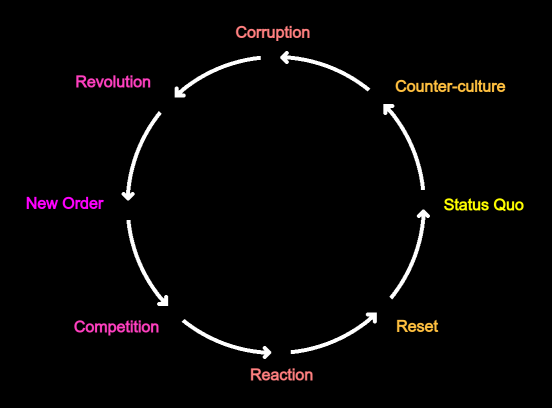Cycle of Tyranny
Cycle of Tyranny is a recurring cyclical pattern existing between traditional and "modernized" forms of obscurantism and oppression; this historically contextualizes the latter as an integral phase in a cycle of self-perpetuation of the usual political/economic powers.
Phases
The cycle undergoes the following phases:
- Status-Quo
The default condition: the vast majority of people are oppressed and exploited by a ruling elite, and a specific ideology or religion is used to justify the existing state of things; this is the time of "traditional" obscurantist rule. - Counter-culture
After continuous exploitation, discontent eventually arises, and ideas of liberation start originating; at first, the establishment's reaction to such ideas is to directly and openly attack them, relegating them to a minoritarian counter-culture and forcing their supporters to act in the shadows. - Corruption
As the opposing ideologies, despite continued suppression, continue to propagate to the point of becoming a concern, the ruling power tries to appropriate them and corrupt them into a distorted version, carefully crafted to suit their interests; this can be done either by infiltrating already existing opposing movements and subverting them from the inside, or by creating puppet ones from the ground up. - Revolution
Once that the entire counter-culture has been thoroughly corrupted and emptied of all its radical emancipatory elements, becoming nothing more than a pawn for the elites, it can be allowed to win and become the new dominant ideology. - New Order
In the places where the revolution happens, a "new" social order arises which is basically undistinguishable from the old one, except formally; this is the time of "modernized" obscurantist rule. - Competition
People are now divided in 2 factions: the supporters of the new order and those who remain loyal to the old one; this might also be reflected in terms of geopolitical division, with a new arising international block opposed to a conservative one that remained faithful to the old order. The evident (and intended) evils brought by the former are used as a warning for the people of the latter from revolting; some concessions might be made for the same purpose, but also to reiterate the superiority of the old order compared to the "new" one. - Reaction
More and more people eventually become disillusioned with the new system, creating a reactionary "counter-culture" that rejects the new order in its entirety; the establishment deals with this in the same way as it dealt with the previous one (that is.: infiltration and subversion). - Reset
When the pushback against the "new" order has become widespread enough, the latter is allowed to collapse; the old order and its ideology (or an equivalent) are restored.

Examples
The following table shows historical examples of the aforementioned cycle.
XVIII/XIX Centuries | XIX/XX Centuries |
Phase 1: Status-Quo | |
Ancién Regime | Imperialism |
Phase 2: Counter-culture | |
The Enlightenment | Socialism |
Phase 3: Corruption | |
Jacobines | Marxism-Leninism |
Phase 4: Revolution | |
French Revolution | Russian Revolution |
Phase 5: New Order | |
Age of Terror | Stalinism |
Phase 6: Competition | |
Absolute monarchies (+ Enlightened Dispotism) | Market economies (+ Welfare State) |
Phase 7: Reaction | |
Defeat of Napoleon | Fall of the USSR |
Phase 8: Reset | |
Restauration | Globalization |
